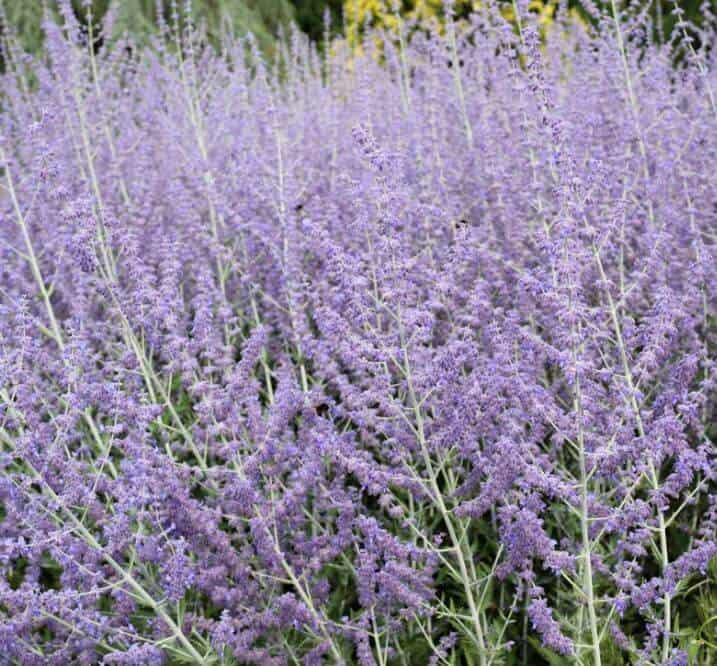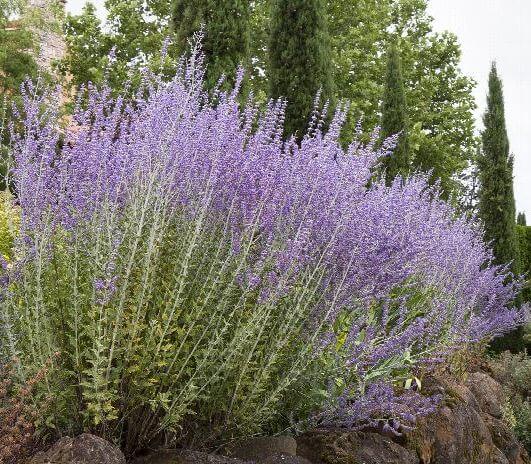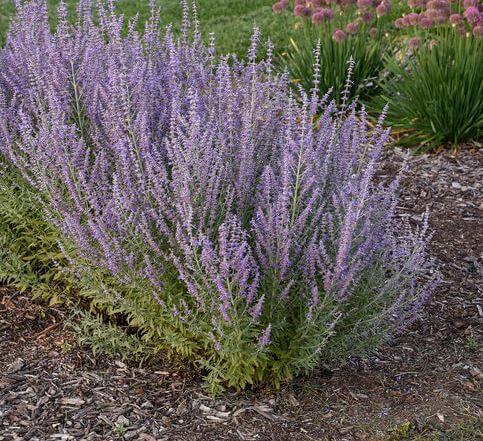Last Updated on January 5, 2023 by a Friendly Gardener
When seeing a lavender sage plant, one might feel a bit confused. Is it one plant or are lavender and sage plants the same thing might cross your mind. The lavender sage plant is more commonly known as the Russian Sage plant. Yet still, you might ask, are the Russian Sage plant and the lavender plants one and the same?
Actually, they are not. The Russian Sage plant also occasionally called the Lavender of Afghanistan is part of the same family and they resemble each other. Although not truly a sage plant or Russian for that matter, the Perovskia Atriplicifoliaor Salvia yangiiis a delightful deciduous shrub that boasts being drought tolerant and is often included in landscape designs under full sun. Russian sage was classified as Perovskia Atriplicifolia until 2017. It was then renamed as Salvia yangii as it was included in the salvia genus.
Russian Sage is native to central Asia and was named to honor Russian General V. A. Pokorski. This Imperial Russian general was the military governor of Orenburg, a Russian province. It was named by GrigoryKarelin, a Russian botanist in 1841.
It is a member of the mint family featuring woody stems and aromatic foliage that hints of crushed sage, although it is not used in cooking. Like many Lamiaceaeor mint family members, it is invasive and a spreader.
Foliage is silvery green in color with tube-shaped bluish lavender blossoms growing in pairs which appear beginning in summer through to autumn. Flowers will then fade and nut-like tiny fruits will appear. Blossoms are edible and are employed in dye making. Foliage is toxic.
Thanks to its fragrance, it is not of interest to rabbits, deer, or other small animals. Some gardeners love the fragrance while others find it undesirable.
It will however attract the bees and the butterflies to your garden. It works well when planted alongside ornamental grasses, sedum, or lavender as well as drought-tolerant succulents like aloe or agaves.
Lavender vs. Sage Plant

Lavender and sage plants are both resilient and very low maintenance. They also both prefer well-draining soil and a location with full sun exposure. Both plants have foliage that contains oil and is used in perfumes, oils, candles, and more, and have edible purple flowers that bloom in the summer. Russian sage blossoms will last longer.
There are several differences however that are worth noting.
- Lavender plants prefer nutrient-poor soil or sand.
- Russian sage can thrive in soil with more moisture from dry to medium soil whereas lavender does not like much water.
- Lavender is often used for culinary purposes in sweets while sage is used in savory dishes.
| Lavender | Characteristics | Russian Sage |
| 1 to 3 feet in height and width | Size | 3 to 4 feet in height and width |
| 5 to 9 | USDA Hardiness zones | 3 to 10 |
| purple | Bloom color | purple |
| Round and tubular | Bloom shape | Tubular spikes |
| Hot and dry | Ideal Climate | Temperate, dry to average |
| sweet | Culinary Use | savory |
Lavender Sage Plant Care

Growing from 3 to 4 feet tall and wide, this shrub likes well-draining soil beds that are bright and sunny. It can be grown successfully in USDA hardiness zones 3 through 10. It requires very little maintenance.
Soil
Lavender sage likes well-draining soil and dislikes anything resembling a soggy growing medium. Ideally, choose a spot in your garden with dry soil. When planting, space plants 18 inches to 2 feet apart. Soil pH should measure 7 or above.
Light
The Lavender sage plant likes full sun, so select its location accordingly. If it is cultivated in a shady spot, it may spread and sprawl out.
Water

Basically, Lavender sage plants thrive best in dry soil. When you plant, however, you should water your plants during dry weather until they have established themselves and show growth. Should you decide to mulch, choose gravel rather than any type of organic mulch as this facilitates the evaporation of too much moisture.
With established plants, watering needs are minimal. You will rarely need to water this shrub.
Temperature
As a plant that likes the sun and requires minimal watering, a temperate climate is desirable. If you are gardening above USDA hardiness zone 6, you can protect your plants with a layer of pine needles approximately 2 inches thick. Remove this protective covering when new growth appears.
Feeding
Lavender sage really does not require fertilization, but you can improve soil nutrients by placing some compost around plants at the end of fall every year.
Pruning

Most of the maintenance required comes down to pruning. During winter you may want to trim your plants to approximately a foot in height above the soil surface for a tidier look in your garden.
You will need to prune in the spring once new growth emerges. Trim the older stems back to just above the lowest leaves. These shrubs tend to spread towards the end of spring and summer. If so, prune one-third of the sprawling stems to stimulate growth upward.
Should plants stop flowering in the summer, prune the top half from stems to encourage new growth and flowering.
Lavender Sage Plant Propagation

The easiest way to propagate your plants is through the division of root clumps. Clumps should be divided every four to six years. This will control the plant’s tendency to spread and reinvigorate the plants.
You can also use seeds or take stem cuttings in the springtime. Some mature established plants may self-sow or spread thanks to rhizomes found underground.
Softwood cuttings can be taken in spring while semi-hardwood cuttings should be taken in summer.
- Select a mature, healthy plant and take several 4-inch cuttings above a leaf node.
- Remove all leaves except those at the tip. Remove both buds and flowers.
- Dip the cut end in rooting hormone and place each in an individual container with moistened sand or soilless growing medium.
- Place cuttings in a sunny spot with a room temperature of roughly 60°F. Roots should appear within several weeks and new growth will begin. The growing medium should remain moist.
- Transplant cuttings when they grow to about a foot high.

Seeds can be sown year-round if done so indoors. Prepare seeds 6 to 8 weeks before the final frost for your area.
- Place seeds in a plastic bag in the refrigerator at approximately 40°F. for roughly 40 to 45 days. This will encourage more rapid germination.
- Proceed to prepare a seed tray with moistened seed-starting growing medium. Place seeds on top of the soil and mix one-half-inch apart. Press them lightly into the soil and cover them with a thin layer of sphagnum moss or soil mix.
- Cover the seed tray with plastic and place it in a spot without direct sunlight that has a temperature between 60° and 65°F.
- Mist seeds occasionally while waiting for germination if the soil surface is dry. Seeds should germinate in 3 months. If they do not germinate within 4 months, they have failed, so toss them.
- Once the seeds sprout, remove the plastic and move to a sunny spot or use a grow light. Water as necessary. When they grow to one inch, transplant them into individual containers with potting soil and sand.
- Transplant at the end of spring or the beginning of summer.

